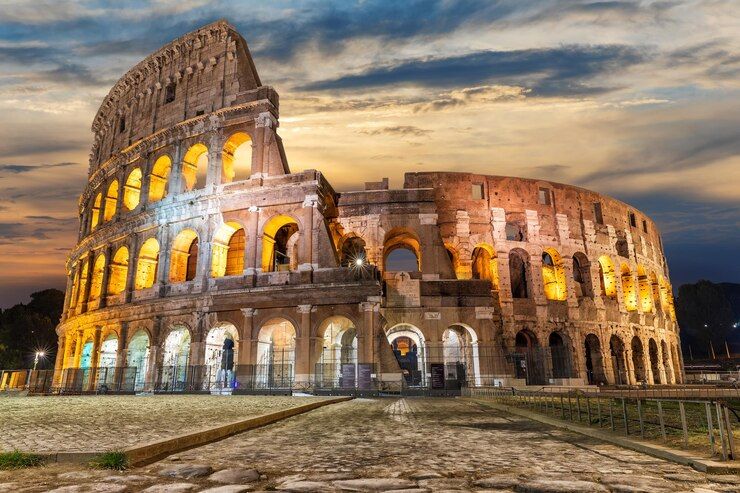In Rome, the Colosseum is one of the most famous places in Europe, also the world. It has enchanted people for centuries.
The Colosseum’s size, architecture, and history are like gems. Visitors are always surprised by this ancient Roman amphitheater. Anyway, This piece of knowledge will provide an in-depth look at the Colosseum.
Since I Explore history by myself, I can share fascinating facts, offer practical tips & many interesting secrets. Whether you’re a history finder or appreciate great architecture, then the Colosseum is the best option to visit. Let’s dive into it.
History of the Colosseum
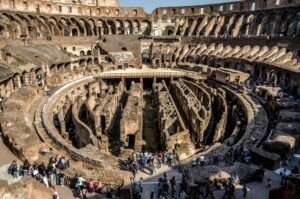
Origins and construction under Emperor Vespasian
The Colosseum was recognized in 70-72 AD by Emperor Vespasian. It was part of the Flavian dynasty and sought to solidify its rule after a period of civil war.
To connect the new imperial dynasty with the people of Rome, the Colosseum on the former site of Nero’s palace.
The Flavian Dynasty and the Colosseum’s completion
Vespasian’s son is Titus, Who made the final stages of the Colosseum in 80 AD.
The Flavian emperors were well known for their ambitious building architecture projects. They also spared no expense in creating this architectural marvel.
In that century, the Roman Empire had a height for its power and resources. Like grand scale, intricate design, and innovative engineering techniques. And which hosts as the centerpiece of Roman entertainment and cultural life.
The purpose and uses of the Colosseum
Gladiatorial contests and spectacles
They were primarily used for gladiatorial contests and other violent spectacles. Whose events were a central part of Roman culture. Especially entertainment, drawing massive crowds, and even battles with wild animals.
Their underground network of tunnels and chambers was used to house the gladiators. These gladiatorial contests were the main source of entertainment. At the same time, it’s also a tool for political propaganda of Roman emperors.
Other events hosted at the Colosseum
The gruesome gladiatorial fights & other events are hosted by a variety of spectacles. These included theatrical re-enactments of famous battles, executions of criminals, animal hunts, and even mock sea battles. ( Place, where the arena was extremely flooded with water).
All in all, this iconic landmark truly served as the epicenter of Roman entertainment. Also, the Colosseum’s cultural life drew in massive crowds and showcased the power of the Roman Empire.
Facts about the Colosseum
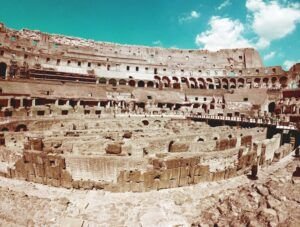
Architectural and engineering marvels
Scale and dimensions
This place has an impressive structure, which covers an area of over 6 acres by stands over 150 feet tall. Its sheer size and scale were truly significant & famous for the period in which it was built.
Materials and construction techniques
It was built using a combination of lightweight concrete, marvel, and stone. This innovative use of materials was used to create open courtyards and tiered seating.
Records and statistics
Seating capacity
Usually, To make the largest amphitheater in Rome of this place could accommodate up to 80,000 spectators. Undoubtedly that’s massive. So that the huge seating capacity allowed it to host large-scale events and entertain the masses in Rome.
Duration of events
Some of the events were held for many days. The longest event lasted for 100 days. That’s a world record even now.
These longest events were a testament to the Romans’ civilization their entertainment and cultural traditions.
Symbolic significance: culture and legacy
The Colosseum was a symbol of the power of the Roman Empire. Also, it has a functional structure. As a result that legacy continues to enchant people from around the world.
If you come further to witness this timeless divine, you can connect with the rich history (Colosseum ). At least visiting this iconic landmark will be worth it.
Visiting The Colosseum
Accessibility and transportation
The Colosseum is located in the middle of Rome. Which made it easily accessible to visitors.
As for Public transportation, there are available metro and bus systems. The vehicles can get you to the site with ease.
Ticketing and admission options
Standard entry
Standard tickets provide you access to the general admission areas of the site. You can purchase tickets to enter the Colosseum and, at the same time, explore the various levels and areas.
Tips: When you fix your mindset to visit, it’s always better to plan and purchase your tickets in advance. Interestingly, You can get an online or an accommodation provider.
Guided tours and specialized experiences
To my past in-depth and informative experience, I highly recommend booking a guided tour of the place. These tour guides always provide valuable insights into the site’s history, architecture, and the daily lives of the gladiators.
In addition to guided tours, the Colosseum offers specialized experience. They are greatly trained for access to the underground tunnels and the arena floor. (Which are not available for standard tickets).
What to See at the Colosseum?
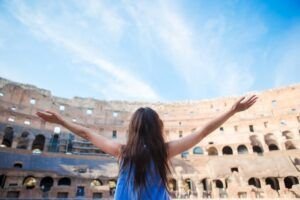
Exploring the different levels and areas
Arena floor and underground
The Colosseum other to any tourist a unique opportunity to explore their arena floor. Beneath the arena floor lies a complex network of tunnels and chambers.
This place is where legendary gladiatorial contests once took place. Similarly, the wild animals were housed before being brought up to the main stage.
Seating tiers and upper levels
Once you climb up the Colosseum’s tiered seating, you can see the roar of the crowd and the intensity.
The upper levels offer stunning views of the surrounding city and the arena. Also, provides a glimpse into the grandeur and scale of this ancient remarkable.
Notable features and highlights
Architectural details
If you want to explore the Colosseum, you should know the intricate architectural details that showcase the Romans’ engineering prowess. It gives you the extra, better trip to make it worth it.
In the construction of this landmark, The grand arches, columns, and decorative elements are a testament.
Exhibits and reconstructions
Within the Colosseum, you’ll see many types of exhibits and reconstructions that bring the site’s history to life.
These include interactive displays and scale models. Also, partial reproductions of the underground tunnels and chambers.
If you go there, these features provide valuable insight into the daily workings and operations of the Colosseum. Later, it enhances your understanding and appreciation of this significant wonder.
Best times to visit
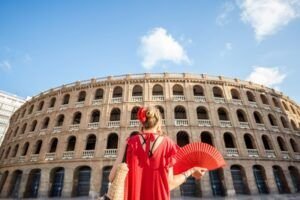
If you fix your mindset to visit the Colosseum, timing is very important for the first steps. As I experienced, it’s better to know the perfect time to visit. However, the best time to visit can vary depending on your preferences and the overall experience you want to have.
- To explore the Colosseum, Early morning and late afternoon are generally considered the optimal times. So tourists tend to be less crowded than in the middle of the day.
- Again, Late afternoon visits offer the added benefit of witnessing the Colosseum in an RGB light. So, you will get the setting sun casts a warm glow over the ancient walls as a tourist.
You allow a schedule! Well, you should try to avoid visiting the iconic landmark during the peak summer months. That time the crowds can be overwhelming. Also, The summer heat can make a bad experience & less comfortable.
Try to consider planning your visit during spring and fall. These times of year offer more good, cool temperatures, and smaller crowds. All in all, it’s the best time to visit, as I experienced.
Another factor is planning to go on Mondays and Tuesdays of the week. These times are generally less crowded than any other weekend. As a result, you can have a more relaxed and enjoyable experience from the trip.
Practical Tips for Your Visit
Avoiding crowds and long lines
If you want to talk about crowds, you must consider booking your tickets in advance online or through your hotel.
You can also try to join a guided tour, which often includes skip-the-line access to the Colosseum.
Recommended attire and essentials to bring
Since the temperature inside the Colosseum can vary, it’s better to wear comfortable shoes and dress.
Note: Don’t forget to bring a bottle of water, sunscreen, a hat, & umbrella, it’ll help you to protect yourself from the sun & make your trip an awesome experience.
Nearby attractions and complementary experiences
Once you fully explore the Colosseum, I recommend you visit the nearby Roman Forum and Palatine Hill. The visit gives you a deeper understanding of ancient Roman history.
Also, it is good to explore the charming streets of Rome, indulge in delicious Italian cuisine, and lastly, soak in the city’s vibrant atmosphere. You know the more you visit different places, the more you learn.
Final Thought
The Colosseum is like a marvel of the ancient world no doubt. It has enchanted people for centuries. A visit to Rome is worth it. Also, not be complete without seeing this iconic landmark.
Whether you’re a history finder or appreciate great architecture, then the Colosseum will leave a lasting impression. Try to Make sure to plan and follow the tips we have given.
Remember, the Colosseum is a must-see destination for any traveler to Rome. I hope With a bit of planning and consideration, you can discover the best time to visit and create lasting memories of your experience. Peace.

